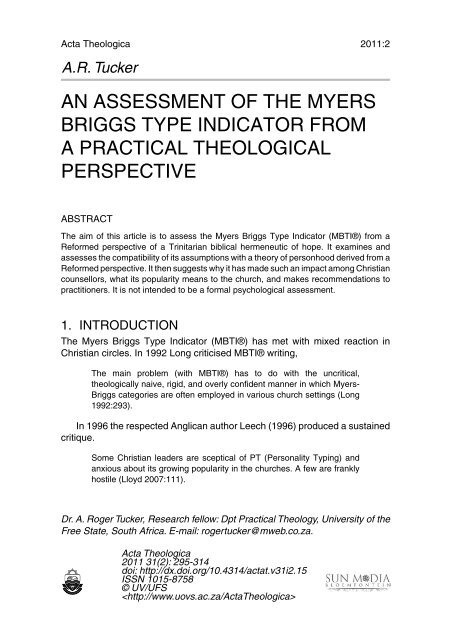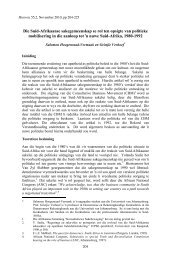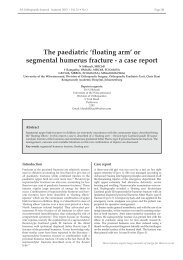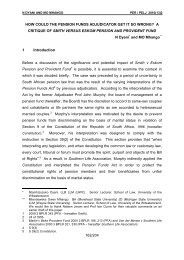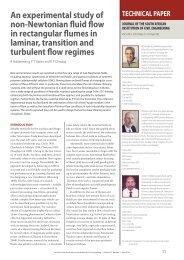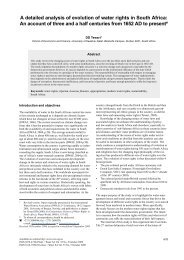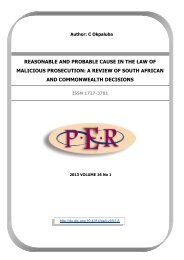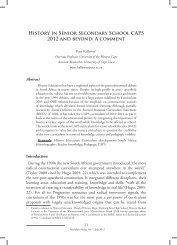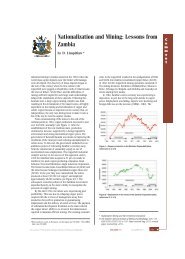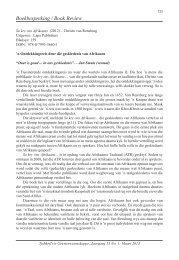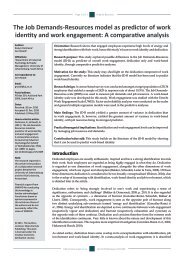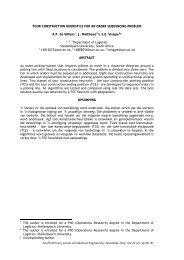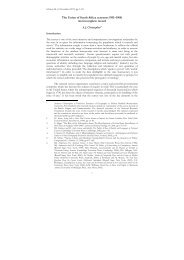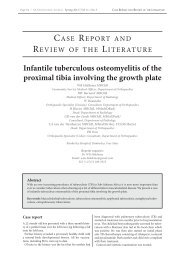an assessment of the myers briggs type indicator from a practical ...
an assessment of the myers briggs type indicator from a practical ...
an assessment of the myers briggs type indicator from a practical ...
Create successful ePaper yourself
Turn your PDF publications into a flip-book with our unique Google optimized e-Paper software.
Acta Theologica 2011:2<br />
A.R. Tucker<br />
AN ASSESSMENT OF THE MYERS<br />
BRIGGS TYPE INDICATOR FROM<br />
A PRACTICAL THEOLOGICAL<br />
PERSPECTIVE<br />
ABSTRACT<br />
The aim <strong>of</strong> this article is to assess <strong>the</strong> Myers Briggs Type Indicator (MBTI®) <strong>from</strong> a<br />
Reformed perspective <strong>of</strong> a Trinitari<strong>an</strong> biblical hermeneutic <strong>of</strong> hope. It examines <strong>an</strong>d<br />
assesses <strong>the</strong> compatibility <strong>of</strong> its assumptions with a <strong>the</strong>ory <strong>of</strong> personhood derived <strong>from</strong> a<br />
Reformed perspective. It <strong>the</strong>n suggests why it has made such <strong>an</strong> impact among Christi<strong>an</strong><br />
counsellors, what its popularity me<strong>an</strong>s to <strong>the</strong> church, <strong>an</strong>d makes recommendations to<br />
practitioners. It is not intended to be a formal psychological <strong>assessment</strong>.<br />
1. INTRODUCTION<br />
The Myers Briggs Type Indicator (MBTI®) has met with mixed reaction in<br />
Christi<strong>an</strong> circles. In 1992 Long criticised MBTI® writing,<br />
The main problem (with MBTI®) has to do with <strong>the</strong> uncritical,<br />
<strong>the</strong>ologically naive, rigid, <strong>an</strong>d overly confident m<strong>an</strong>ner in which Myers-<br />
Briggs categories are <strong>of</strong>ten employed in various church settings (Long<br />
1992:293).<br />
In 1996 <strong>the</strong> respected Anglic<strong>an</strong> author Leech (1996) produced a sustained<br />
critique.<br />
Some Christi<strong>an</strong> leaders are sceptical <strong>of</strong> PT (Personality Typing) <strong>an</strong>d<br />
<strong>an</strong>xious about its growing popularity in <strong>the</strong> churches. A few are fr<strong>an</strong>kly<br />
hostile (Lloyd 2007:111).<br />
Dr. A. Roger Tucker, Research fellow: Dpt Practical Theology, University <strong>of</strong> <strong>the</strong><br />
Free State, South Africa. E-mail: rogertucker@mweb.co.za.<br />
Acta Theologica<br />
2011 31(2): 295-314<br />
doi: http://dx.doi.org/10.4314/actat.v31i2.15<br />
ISSN 1015-8758<br />
© UV/UFS<br />
Tucker<br />
An <strong>assessment</strong> <strong>of</strong> <strong>the</strong> Myers Brigss Type <strong>indicator</strong><br />
It still meets with this mixed reaction. Yet it is widely regarded as a valuable<br />
tool in m<strong>an</strong>y countries <strong>of</strong> <strong>the</strong> world for underst<strong>an</strong>ding oneself <strong>an</strong>d for relating<br />
to <strong>an</strong>d working with o<strong>the</strong>rs. Despite <strong>the</strong> above criticisms, MBTI® has had a<br />
signific<strong>an</strong>t impact within <strong>the</strong> Christi<strong>an</strong> church, certainly in <strong>the</strong> USA <strong>an</strong>d <strong>the</strong><br />
UK.<br />
MBTI® has been advocated as <strong>an</strong> <strong>indicator</strong> <strong>of</strong> how successful ministers will<br />
be in leading a church into ch<strong>an</strong>ge (Malphurs 1993:64-68), improving teamwork<br />
(Malphurs 2005:110), <strong>an</strong>d as a tool for assessing how a congregation will<br />
react to this ch<strong>an</strong>ge (Douglass 2008). It is being used by <strong>the</strong> church to make<br />
employment decisions, establish leadership styles, regulate staff relationships,<br />
<strong>an</strong>d advise people about everything <strong>from</strong> marriage roles to prayer techniques<br />
(see Dunc<strong>an</strong> 1993). On two different occasions two qualified psychologists<br />
administered <strong>the</strong> MBTI® to <strong>the</strong> author, a Presbyteri<strong>an</strong> minister.<br />
It is <strong>the</strong>refore wrong to dismiss <strong>the</strong> MBTI® out <strong>of</strong> h<strong>an</strong>d. The Bible’s<br />
Wisdom literature genre indicates that through reflection on nature <strong>an</strong>d hum<strong>an</strong><br />
life in general wise insights may be gained that c<strong>an</strong> be appropriated by <strong>the</strong><br />
righteous. This implies that <strong>the</strong> Christi<strong>an</strong> world has a great deal to learn <strong>from</strong><br />
sources o<strong>the</strong>r th<strong>an</strong> revelation, such as <strong>the</strong> natural <strong>an</strong>d operational sciences,<br />
folk wisdom <strong>an</strong>d culture (Osmer 2008:88ff.), <strong>an</strong>d this may apply to such<br />
psychological tools as MBTI®. However, ideas <strong>from</strong> <strong>the</strong>se sources should not<br />
be accepted <strong>an</strong>d used without a critical <strong>the</strong>ological examination.<br />
As far as <strong>the</strong> author c<strong>an</strong> ascertain, <strong>the</strong>re do not appear to be <strong>an</strong>y Practical<br />
Theological studies formally <strong>an</strong>d methodologically assessing MBTI®. Practical<br />
Theology is equipped to undertake this topic in a systematic fashion, taking<br />
into account <strong>the</strong> interaction between <strong>the</strong>ology <strong>an</strong>d social context. This Practical<br />
Theological <strong>assessment</strong> <strong>of</strong> <strong>the</strong> MBTI® interrogates its assumptions <strong>from</strong> <strong>the</strong><br />
hermeneutical-critical approach advocated by Heitink (1999:178ff.). This<br />
approach is based on <strong>the</strong> assumption that <strong>the</strong> purpose <strong>of</strong> Practical Theology<br />
is to ensure that God’s Word reaches people <strong>an</strong>d is embodied in <strong>the</strong>ir lives.<br />
2. THE HERMENEUTICAL APPROACH AS A MEANS<br />
OF ASSESSMENT<br />
2.1 Description <strong>of</strong> Practical Theological model adopted<br />
The Practical Theological methodological model used to assess <strong>the</strong> MBTI®<br />
is <strong>of</strong> crucial import<strong>an</strong>ce as it will to a large extent determine <strong>the</strong> interpretation<br />
<strong>of</strong> <strong>the</strong> results <strong>of</strong> <strong>the</strong> <strong>assessment</strong> <strong>an</strong>d <strong>the</strong> conclusions. The approach adopted<br />
in this study may be called <strong>the</strong> hermeneutical-critical approach. Practical<br />
Theology is regarded as <strong>the</strong> interaction between <strong>the</strong>ological tradition, a<br />
296
Acta Theologica 2011:2<br />
biblical hermeneutic <strong>an</strong>d <strong>the</strong> social context in which <strong>the</strong> church finds itself<br />
(Zerfass 1974:168).<br />
The interaction may be envisaged as <strong>an</strong> interactive spiral which starts<br />
<strong>from</strong> <strong>the</strong> praxis (<strong>the</strong> situation). The praxis is reflected upon <strong>from</strong> a <strong>the</strong>ological<br />
perspective (<strong>the</strong> <strong>the</strong>ory) <strong>an</strong>d <strong>the</strong> results are used to interrogate <strong>the</strong> interpretation<br />
<strong>of</strong> <strong>the</strong>ory. The new <strong>the</strong>ory <strong>the</strong>n questions <strong>the</strong> existing praxis, causing it to be<br />
re-examined, <strong>an</strong>d so on. A progressive spiral is initiated, with a time dimension,<br />
in which research <strong>of</strong> <strong>the</strong> context leads to a new interpretation <strong>of</strong> <strong>the</strong> text which,<br />
in turn, sheds new light on <strong>the</strong> actual situation (Heitink 1999:153ff.).<br />
2.2 A hermeneutical-critical approach in <strong>the</strong> context <strong>of</strong><br />
<strong>the</strong> Trinity<br />
The most pr<strong>of</strong>ound way, for a Reformed Theologi<strong>an</strong>, <strong>of</strong> applying <strong>the</strong><br />
hermeneutical-critical approach is within <strong>the</strong> context <strong>of</strong> <strong>the</strong> Trinity. This is <strong>the</strong><br />
framework upon which Calvin based his Institutes (Method <strong>an</strong>d Arr<strong>an</strong>gement:<br />
I, II, III) <strong>an</strong>d has been re-emphasised by Barth in his Church Dogmatics (Vol.1<br />
1936). It examines what <strong>the</strong> Bible tells us about God <strong>the</strong> Fa<strong>the</strong>r, God <strong>the</strong> Son<br />
<strong>an</strong>d God <strong>the</strong> Holy Spirit in relation to <strong>the</strong> hum<strong>an</strong> being since hum<strong>an</strong> beings<br />
are <strong>the</strong> result <strong>of</strong> a Trinitari<strong>an</strong> intervention in <strong>the</strong> world. Thus <strong>an</strong>y Practical<br />
Theology study must be axiomatically Trinitari<strong>an</strong> (Purves 1998:224.)<br />
A Trinitari<strong>an</strong> approach provides <strong>the</strong> basis <strong>an</strong>d <strong>the</strong> broadest horizon for<br />
Practical Theology. It helps to ensure that it is based on a biblical hermeneutic.<br />
It provides <strong>the</strong> only satisfactory <strong>the</strong>ological hermeneutic whereby <strong>the</strong> world c<strong>an</strong><br />
be studied both empirically <strong>an</strong>d <strong>the</strong>ologically, allowing God to be perceived<br />
as “o<strong>the</strong>r” th<strong>an</strong> creation <strong>an</strong>d in relation to it. The dist<strong>an</strong>cing <strong>of</strong> “o<strong>the</strong>rness”<br />
provides <strong>the</strong> freedom necessary for m<strong>an</strong> <strong>an</strong>d society to act <strong>an</strong>d observe as<br />
autonomous entities while still being intimate with God (Gunton 1991:132).<br />
2.3 The hermeneutical-critical approach in <strong>the</strong> context<br />
<strong>of</strong> <strong>the</strong> <strong>the</strong>ology <strong>of</strong> hope<br />
In addition, a <strong>the</strong>ology <strong>of</strong> hope (Moltm<strong>an</strong>n 1967) is employed as a me<strong>an</strong>s <strong>of</strong><br />
<strong>assessment</strong>. This is rooted in <strong>the</strong> biblical hermeneutic <strong>of</strong> hope with its basis<br />
in <strong>the</strong> Old Testament (von Rad 1966; Brueggem<strong>an</strong>n 1997:476). It opens<br />
up positively oriented hermeneutical structures for relating biblical faith to a<br />
modern world in which <strong>the</strong>re has been a disintegration <strong>of</strong> “<strong>the</strong> self-hood <strong>of</strong><br />
modernity” <strong>an</strong>d thus a loss <strong>of</strong> me<strong>an</strong>ing <strong>an</strong>d purpose (Thiselton 1995:122).<br />
297
Tucker<br />
An <strong>assessment</strong> <strong>of</strong> <strong>the</strong> Myers Brigss Type <strong>indicator</strong><br />
3. DESCRIPTION OF THE MEYERS BRIGGS<br />
PERSONALITY INDICATOR<br />
The MBTI® was developed by Isabel Meyers <strong>an</strong>d her mo<strong>the</strong>r Ka<strong>the</strong>rine<br />
Briggs for two reasons (Black 1980:ix). The first was out <strong>of</strong> concern for<br />
hum<strong>an</strong> reconciliation. The <strong>the</strong>ory was that, if people could better underst<strong>an</strong>d<br />
<strong>the</strong>mselves <strong>an</strong>d o<strong>the</strong>rs, destructive hum<strong>an</strong> conflict would be avoided or,<br />
at least, moderated. Once a person recognised his/her own personality<br />
tendencies, <strong>an</strong>d became aware that not everyone possesses those same<br />
tendencies, this would result in greater self-awareness <strong>an</strong>d a greater toler<strong>an</strong>ce<br />
<strong>of</strong> <strong>the</strong> innate differences among people (Black 1980:ix-xii; Long 1992:291).<br />
The second was that different vocations favoured different personality <strong>type</strong>s<br />
<strong>an</strong>d that Jung’s <strong>the</strong>ory, with Brigg’s modifications, provided <strong>the</strong> <strong>the</strong>oretical<br />
structure to link personality to job perform<strong>an</strong>ce (Briggs & Meyers 1980:157ff.;<br />
Pittenger 1993:468).<br />
MBTI® eliminates some <strong>of</strong> Jung’s concepts, modifies o<strong>the</strong>rs <strong>an</strong>d adds<br />
some new <strong>the</strong>ories. Jung (1938:9ff.) suggested that personality could<br />
be described by a typology based on <strong>the</strong> two opposite orientations <strong>of</strong> <strong>the</strong><br />
self (extraversion or introversion), <strong>the</strong> two opposite processes whereby we<br />
perceive information (sensing or intuition), <strong>an</strong>d <strong>the</strong> two opposite processes<br />
whereby we make judgements (feeling or thinking). Brigg’s <strong>the</strong>ory added <strong>the</strong><br />
“judgment-perceptive” dichotomy <strong>an</strong>d ignored <strong>the</strong> concept <strong>of</strong> <strong>the</strong> unconscious<br />
<strong>an</strong>d its relation to domin<strong>an</strong>t <strong>an</strong>d auxiliary functions <strong>an</strong>d <strong>the</strong> development <strong>of</strong><br />
compensatory processes in <strong>the</strong> subconscious (Pittenger 1993:469).<br />
Thus <strong>the</strong> MBTI® seeks to disclose a person’s preferences among four<br />
pairs <strong>of</strong> personality variables: two basic attitudes (extraversion or introversion),<br />
two kinds <strong>of</strong> perception (sensing or intuiting), two m<strong>an</strong>ners <strong>of</strong> seeking rational<br />
order (thinking or feeling), <strong>an</strong>d two varieties <strong>of</strong> orientation toward <strong>the</strong> outer<br />
world (perceptive or judging). This ma<strong>the</strong>matically produced sixteen possible<br />
combinations, or personality “<strong>type</strong>s”, each expressed in shorth<strong>an</strong>d by a fourletter<br />
code (Briggs & Meyers 1980:1ff.; Keirsey & Bates 1984:13ff.; Long<br />
1992:291ff.). The contention is that, while everybody on occasion uses all <strong>the</strong><br />
eight preference poles listed above, each <strong>of</strong> us mostly prefers one <strong>of</strong> each <strong>of</strong><br />
<strong>the</strong>se opposites <strong>of</strong> <strong>the</strong>se four pairs <strong>an</strong>d thus each individual c<strong>an</strong> be assigned<br />
to one <strong>of</strong> 16 personality <strong>type</strong>s (Briggs & Meyers 1980:1; Lloyd 2007:120).<br />
The objective <strong>of</strong> <strong>an</strong> MBTI® <strong>assessment</strong> is to identify preferences as<br />
accurately as possible by arr<strong>an</strong>ging <strong>the</strong>m into <strong>the</strong> <strong>type</strong> category to which <strong>the</strong>y<br />
are disposed. All <strong>the</strong> questions are presented in a forced choice format, so<br />
that <strong>the</strong> respondent must choose between two mental functions or attitudes<br />
(Quenk 2000:5ff.). The method used to achieve this was to create <strong>an</strong> easily<br />
administered, uncomplicated questionnaire whereby ordinary people could<br />
quickly determine <strong>the</strong>ir psychological personality <strong>type</strong> (Black 1980:ix-xii; Long<br />
298
Acta Theologica 2011:2<br />
1992:291). The self-administered questionnaire now has a list <strong>of</strong> 93 questions<br />
that are scored for <strong>type</strong> (Quenk 2000:5).<br />
4. DISCUSSION OF ASSUMPTIONS UPON WHICH<br />
MBTI® IS BASED<br />
Isobel Briggs makes <strong>the</strong> assumption that MBTI®, <strong>an</strong>d Jung’s <strong>the</strong>ory <strong>of</strong><br />
psychological <strong>type</strong>s upon which it is based, will be very helpful for clergy<br />
(Briggs & Meyers 1980:preface). The implication <strong>of</strong> this, <strong>an</strong>d <strong>the</strong> citation <strong>of</strong><br />
Rom<strong>an</strong>s 12:4-8 (Briggs & Meyers 1980:211), is that <strong>the</strong> <strong>the</strong>ory behind MBTI®<br />
is compatible with biblical revelation. The evidence whe<strong>the</strong>r or not this is<br />
so is provided below where each apparent assumption behind <strong>the</strong> <strong>the</strong>ory is<br />
assessed.<br />
4.1 Each individual is unique <strong>an</strong>d different<br />
The first premise <strong>of</strong> MBTI® is that people are unique <strong>an</strong>d different. From a<br />
common sense perspective this seems obvious, although in <strong>the</strong> light <strong>of</strong> <strong>the</strong><br />
postmodern deconstructionist critique, such as Foucault’s (1974) “The Order<br />
<strong>of</strong> Things”, it must be openly stated as a Christi<strong>an</strong> premise. The premise <strong>of</strong><br />
uniqueness is fully in accord with a <strong>the</strong>ological <strong>an</strong>thropology which starts <strong>from</strong><br />
<strong>the</strong> presupposition that <strong>the</strong> selfness <strong>of</strong> all hum<strong>an</strong> beings is determined by <strong>the</strong><br />
concept <strong>of</strong> m<strong>an</strong> created in <strong>the</strong> imago Dei (Genesis 1:27), “So God created<br />
m<strong>an</strong> in his own image”.<br />
In <strong>the</strong> context <strong>of</strong> a dialogue with postmodernity this verse may be interpreted<br />
as indicating that every hum<strong>an</strong> self is genetically determined according to<br />
God’s purpose to be a structured, distinct, determinate, unique entity with<br />
<strong>an</strong> identity <strong>of</strong> selfness, influenced as it develops by existing place, culture<br />
<strong>an</strong>d gender, continuously contingent upon God <strong>an</strong>d moulded by <strong>the</strong> Godgiveness<br />
<strong>of</strong> life. Perhaps <strong>the</strong> most convincing argument for <strong>the</strong> uniqueness <strong>of</strong><br />
each individual created by God is <strong>the</strong> teleological doctrine <strong>of</strong> God’s personal<br />
judgement <strong>of</strong> every individual, as clearly enunciated in <strong>the</strong> New Testament<br />
(2 Corinthi<strong>an</strong>s 5:10; Revelation 20:12-13). If all or even some <strong>of</strong> us were <strong>the</strong><br />
same, this would be cruel <strong>an</strong>d/or pointless.<br />
4.2 This uniqueness c<strong>an</strong> be me<strong>an</strong>ingfully measured by<br />
personality <strong>type</strong><br />
Black (1980:xiff.) claims that MBTI® measures personality. It is worthwhile<br />
pointing out that Jung himself did not go so far as to claim that personality<br />
299
Tucker<br />
An <strong>assessment</strong> <strong>of</strong> <strong>the</strong> Myers Brigss Type <strong>indicator</strong><br />
could be measured. Jung defines personality as <strong>the</strong> fullness <strong>of</strong> hum<strong>an</strong><br />
existence, <strong>the</strong>n concludes his work,<br />
Yet what is called personality is a great <strong>an</strong>d mysterious question. All that<br />
c<strong>an</strong> be said about it is curiously unsatisfactory <strong>an</strong>d inadequate … <strong>the</strong><br />
very concept <strong>of</strong> personality is so vague <strong>an</strong>d badly defined in common<br />
usage that hardly two minds will take <strong>the</strong> word in <strong>the</strong> same sense. I<br />
should like to consider everything that I say … as a mere attempt to<br />
approach <strong>the</strong> problem <strong>of</strong> personality, without making <strong>an</strong>y claim to solve<br />
it (Jung 1940:281ff.).<br />
It is obvious that Jung was not sure what relationship psychological <strong>type</strong>s<br />
had with personality in its wholeness or what a “<strong>type</strong>” precisely represented.<br />
This seems to be made explicit when Jung (1940: 287) writes that, “only our<br />
actions … reveal who we are.” With this statement he seems to declare that it<br />
c<strong>an</strong>not be measured using a psychometric test.<br />
Therefore it must be concluded that <strong>the</strong> relationship between what is being<br />
measured by MBTI® <strong>an</strong>d personality is not clear. This is admitted by some<br />
MBTI® advocates such as Dunc<strong>an</strong> (1993:84) who writes that <strong>the</strong>re are m<strong>an</strong>y<br />
o<strong>the</strong>r things besides personality <strong>type</strong> that influence who we are <strong>an</strong>d how we<br />
behave. If, as Dunc<strong>an</strong> states, that <strong>type</strong> classification does not explain <strong>the</strong><br />
individual psyche, what does it explain or indicate? Lloyd’s (2007:119) <strong>an</strong>swer<br />
is that it indicates, “certain facets <strong>of</strong> hum<strong>an</strong> personality, inbuilt preferences<br />
for certain ways <strong>of</strong> interacting with <strong>the</strong> world. That is all.” The implication is<br />
that “<strong>type</strong>” possibly indicates little more th<strong>an</strong> how individuals are classified<br />
by <strong>the</strong> MBTI® classification, <strong>an</strong>d nothing else. It appears to have very little to<br />
do with indicating personality as defined by m<strong>an</strong>y psychologists, sociologists,<br />
<strong>an</strong>d <strong>the</strong>ologi<strong>an</strong>s.<br />
In addition, <strong>the</strong> self revealed by a biblical <strong>an</strong>thropology highlights <strong>the</strong><br />
impossibility <strong>of</strong> <strong>the</strong> hum<strong>an</strong> self being measured by <strong>an</strong>y test in <strong>an</strong>y me<strong>an</strong>ingful<br />
way. This is <strong>the</strong> result <strong>of</strong> <strong>the</strong> immeasurable relational complexity <strong>an</strong>d mystery<br />
<strong>of</strong> hum<strong>an</strong> beings as tr<strong>an</strong>scendent creatures.<br />
Hum<strong>an</strong> beings are created with a unique capacity to be in relationship with<br />
God (V<strong>an</strong>hoozer 1997:163). Because <strong>of</strong> this, <strong>the</strong> hum<strong>an</strong> self must be defined<br />
as a mystery, incapable <strong>of</strong> being understood in its totality <strong>an</strong>d maybe even in<br />
part. The imago Dei indicates that all hum<strong>an</strong> beings were created with this<br />
capacity. Genesis 2:7 states, “<strong>the</strong> LORD God formed <strong>the</strong> m<strong>an</strong> <strong>from</strong> <strong>the</strong> dust<br />
<strong>of</strong> <strong>the</strong> ground <strong>an</strong>d brea<strong>the</strong>d into his nostrils <strong>the</strong> breath <strong>of</strong> life, <strong>an</strong>d <strong>the</strong> m<strong>an</strong><br />
became a living being.” Hum<strong>an</strong> beings are revealed as receiving <strong>the</strong> breath<br />
<strong>of</strong> God enabling a unique <strong>an</strong>d special relationship with Him as part <strong>of</strong> <strong>the</strong>ir<br />
ontology.<br />
300
Acta Theologica 2011:2<br />
As a result <strong>the</strong>y may even be considered as “mediating within creation<br />
<strong>the</strong> imm<strong>an</strong>ence <strong>of</strong> <strong>the</strong> tr<strong>an</strong>scendent Creator” (Grenz 2005:88). Thus hum<strong>an</strong><br />
beings are “<strong>the</strong> creature <strong>of</strong> <strong>the</strong> boundary between heaven <strong>an</strong>d earth” (Barth<br />
1966:63). They are incapable <strong>of</strong> being summarised by <strong>an</strong>y psychometric test<br />
because <strong>the</strong>y are tr<strong>an</strong>scendent, in relationship with God <strong>an</strong>d thus a mystery.<br />
Fur<strong>the</strong>rmore, <strong>the</strong> imago Dei indicates that hum<strong>an</strong> beings not only need<br />
to relate to God but to each o<strong>the</strong>r as <strong>an</strong> ontological necessity. Moltm<strong>an</strong>n<br />
(1981:156ff.) introduced relationality into <strong>the</strong> being <strong>of</strong> God <strong>an</strong>d thus places<br />
community-ness within <strong>the</strong> Trinity. Thus <strong>the</strong> imago Dei undergirds m<strong>an</strong>kind’s<br />
need for community-ness (McIntyre 1997:27, 208 ff.). This is such <strong>an</strong><br />
ontological reality that all hum<strong>an</strong> beings are deeply influenced <strong>an</strong>d moulded<br />
by this community-ness. And as <strong>the</strong> separate persons <strong>of</strong> <strong>the</strong> Trinity c<strong>an</strong>not<br />
be understood fully in <strong>an</strong>d <strong>of</strong> <strong>the</strong>mselves, hum<strong>an</strong> beings made in <strong>the</strong> imago<br />
Dei c<strong>an</strong>not be understood in <strong>the</strong>ir complexity without underst<strong>an</strong>ding <strong>the</strong><br />
whole. This me<strong>an</strong>s that, taking into account <strong>the</strong>ir mystery, even a part <strong>of</strong> <strong>the</strong>ir<br />
selfhood c<strong>an</strong>not be understood since it is only by observing how <strong>the</strong>y relate<br />
to everybody that <strong>an</strong> accurate holistic picture c<strong>an</strong> be determined. And <strong>the</strong><br />
relational aspect affects every aspect <strong>of</strong> being! How c<strong>an</strong> <strong>an</strong>y psychometric<br />
test measure all this? As Louw (2008:78) comments, “It is nearly impossible to<br />
capture <strong>the</strong> me<strong>an</strong>ing <strong>of</strong> soul in a <strong>the</strong>ory <strong>of</strong> personhood or personality <strong>type</strong>.”<br />
4.3 Personality <strong>type</strong> is innate <strong>an</strong>d unch<strong>an</strong>ging<br />
Ano<strong>the</strong>r crucial assumption <strong>of</strong> MBTI® is that personality <strong>type</strong> is innate <strong>an</strong>d<br />
unch<strong>an</strong>ging throughout life (Lloyd 2007:120). Unless this is assumed <strong>the</strong><br />
<strong>indicator</strong> loses its rationale, namely to predict career competency, forecast<br />
<strong>the</strong> strengths <strong>an</strong>d weaknesses <strong>of</strong> marriage interrelationships <strong>an</strong>d <strong>the</strong> best<br />
educational practices for children, <strong>an</strong>d help people underst<strong>an</strong>d <strong>the</strong>mselves<br />
<strong>an</strong>d o<strong>the</strong>rs.<br />
What is precisely me<strong>an</strong>t by innate is not clear. Does it me<strong>an</strong> that personality<br />
<strong>type</strong> exists <strong>from</strong> conception, birth or later? It appears that Briggs & Meyers<br />
(1980:2, 25) believe that personality <strong>type</strong> is innate in <strong>the</strong> sense that it begins<br />
to develop as soon as children exercise a preference which determines <strong>the</strong><br />
course <strong>of</strong> future development. Whe<strong>the</strong>r or not this is <strong>the</strong> case, <strong>the</strong> me<strong>an</strong>ing<br />
must include <strong>the</strong> idea that something within <strong>the</strong> genetic template determines<br />
<strong>the</strong> preferred choice <strong>of</strong> <strong>type</strong> formed at <strong>an</strong> early stage <strong>of</strong> <strong>the</strong> self’s existence.<br />
There is some <strong>the</strong>ological justification for this position when considering<br />
<strong>the</strong> self in <strong>the</strong> short term. God is <strong>the</strong> great “I am” (Exodus 3:14). Yahweh has<br />
existed as <strong>an</strong> identity, structured as a Trinity <strong>of</strong> persons, <strong>from</strong> all eternity. Thus<br />
<strong>the</strong> imago Dei implies that hum<strong>an</strong> beings are beings that exist with structured<br />
identities, ei<strong>the</strong>r potentially or actually, <strong>from</strong> <strong>the</strong> moment <strong>of</strong> <strong>the</strong>ir individual<br />
301
Tucker<br />
An <strong>assessment</strong> <strong>of</strong> <strong>the</strong> Myers Brigss Type <strong>indicator</strong><br />
creation. Hum<strong>an</strong>kind, like God, has <strong>an</strong> “enduring identity <strong>an</strong>d thus a specific<br />
ontology” (Webster 2003:226). This me<strong>an</strong>s that hum<strong>an</strong> beings mostly act<br />
predictably <strong>an</strong>d consistently. If this were not <strong>the</strong> case, hum<strong>an</strong> relationships<br />
would be chaotic <strong>an</strong>d probably unsustainable.<br />
However, <strong>the</strong>re is no long-term <strong>the</strong>ological support for this assumption<br />
<strong>of</strong> <strong>the</strong> fixity <strong>of</strong> <strong>the</strong> hum<strong>an</strong> personality. In fact, <strong>the</strong> biblical witness is that <strong>the</strong><br />
hum<strong>an</strong> self is extremely plastic, in <strong>the</strong> long term. The factors that contribute<br />
to this plasticity are choice, calling, environment (place, culture, experiences,<br />
<strong>an</strong>d relationships), faith <strong>an</strong>d becoming a new creation in Christ Jesus.<br />
Despite being born with a genetic template we have <strong>the</strong> freedom to make<br />
a wide r<strong>an</strong>ge <strong>of</strong> moral, behavioural, social, volitional, faith-based, spiritual <strong>an</strong>d<br />
even, at times, emotional choices. Those created in <strong>the</strong> image <strong>of</strong> God have,<br />
<strong>from</strong> <strong>the</strong> hum<strong>an</strong> perspective, <strong>the</strong> free will to choose or reject God <strong>an</strong>d his ways<br />
in all <strong>the</strong>ir actions. These choices ch<strong>an</strong>ge us. In Galati<strong>an</strong>s 6:7, 8, <strong>the</strong> Pauline<br />
author makes <strong>the</strong> point that,<br />
A m<strong>an</strong> reaps what he sows. The one who sows to please his sinful<br />
nature, <strong>from</strong> that nature will reap destruction; <strong>the</strong> one who sows to<br />
please <strong>the</strong> Spirit, <strong>from</strong> <strong>the</strong> Spirit will reap eternal life.<br />
While <strong>the</strong>re are limits to <strong>the</strong> ch<strong>an</strong>ge <strong>the</strong> Bible does not delineate what <strong>the</strong>se<br />
limits are, except that as long as we say, “No” to God’s call into fellowship with<br />
Him, we are unconsciously subject to <strong>the</strong> power <strong>of</strong> our sinful natures, causing<br />
us to destroy ourselves <strong>an</strong>d harm those with whom we relate.<br />
One choice hum<strong>an</strong> beings must make is to accept or reject God’s calling.<br />
Calling determines what self becomes (Webster 2003:229). Calling is closely<br />
connected with Imago Dei. Men <strong>an</strong>d women were called immediately <strong>the</strong>y<br />
were created to “Be fruitful <strong>an</strong>d increase in number; fill <strong>the</strong> earth <strong>an</strong>d subdue<br />
it.” Calling is a <strong>the</strong>me that became prominent among <strong>the</strong> later prophets <strong>an</strong>d<br />
in <strong>the</strong> New Testament (Isaiah 41:9; 42:6; 48:12; 49:1; Is 52:1; Luke 6:13;<br />
Rom<strong>an</strong>s 1: 6,7; 8: 28, 30; 9:27; 1 Cor 1:1; 1 Cor 7:17; Galati<strong>an</strong>s 1:15). Calvin<br />
(Institutes III:X.vi) writes,<br />
… <strong>the</strong> Lord enjoins every one <strong>of</strong> us, in all <strong>the</strong> actions <strong>of</strong> life to have<br />
respect to our own calling … he has assigned distinct duties to each in<br />
<strong>the</strong> different modes <strong>of</strong> life by <strong>the</strong> name <strong>of</strong> callings.<br />
As called individuals all hum<strong>an</strong> beings are in “a perpetual movement <strong>of</strong><br />
receiving <strong>an</strong>d responding to a gift” (Webster 2003:228). Calling shapes <strong>an</strong>d<br />
moulds <strong>the</strong> individual. In addition, a hum<strong>an</strong> being c<strong>an</strong> achieve <strong>an</strong>ything that is<br />
within <strong>the</strong> limits <strong>of</strong> <strong>the</strong> God-given calling.<br />
302
Acta Theologica 2011:2<br />
The Bible witnesses in general that faith, culture, norms, morals,<br />
experiences, relationships, <strong>an</strong>d purpose all influence selfhood for all hum<strong>an</strong><br />
beings. These are all teleological in <strong>the</strong>ir consequences. A hum<strong>an</strong> person is<br />
a being propelled forward by <strong>an</strong> imponderable complex <strong>of</strong> ultimate norms,<br />
values, <strong>an</strong>d a quest for signific<strong>an</strong>ce <strong>an</strong>d me<strong>an</strong>ing. People live in place <strong>an</strong>d<br />
space <strong>an</strong>d are <strong>the</strong>refore extremely sensitive to reactions, responses <strong>an</strong>d<br />
attitudes within that space <strong>an</strong>d place (Louw 2008:26ff.). While we strive to<br />
categorise in order to predict responses all <strong>the</strong> time, <strong>the</strong>se are sometimes<br />
unpredictably surprising. This is due to <strong>the</strong> fact that how we relate to o<strong>the</strong>rs is<br />
capable <strong>of</strong> ch<strong>an</strong>ging in ways that c<strong>an</strong>not be predicted by <strong>an</strong>y scientific <strong>the</strong>ory<br />
or intuitive underst<strong>an</strong>ding.<br />
M<strong>an</strong>y <strong>of</strong> <strong>the</strong> influences mentioned above are not benign. The “sin complex”<br />
within us adversely moulds <strong>the</strong> development <strong>of</strong> self.<br />
God’s creatures repudiate <strong>the</strong>ir absolute derivation … seeking by a<br />
perverse <strong>an</strong>d counter-act <strong>of</strong> self-creation to be hum<strong>an</strong> in a way o<strong>the</strong>r<br />
th<strong>an</strong> that purposed by <strong>the</strong> creator (Webster 2003:225).<br />
The consequences <strong>of</strong> this are self-unmaking <strong>an</strong>d a self-destruction that<br />
destroys intimate communion between hum<strong>an</strong> beings <strong>an</strong>d God (Rom 6:23:<br />
For <strong>the</strong> wages <strong>of</strong> sin is death). We are flawed creatures who do not underst<strong>an</strong>d<br />
our own actions (Rom<strong>an</strong>s 7:15). There is a deep-seated sin complex within us<br />
which ei<strong>the</strong>r unconsciously influences our actions or to which we consciously<br />
choose to surrender (Jeremiah 17:9; Rom<strong>an</strong>s 7:18-23).<br />
If life is not received or experienced as a gift <strong>from</strong> God, contact with reality<br />
is ultimately severed <strong>an</strong>d futility is <strong>the</strong> result. The individual’s ability to respond<br />
effectively to <strong>the</strong> call <strong>of</strong> God or fulfil God-given potential is damaged. Unhelpful<br />
choices are made in reaction to relational, environmental <strong>an</strong>d cultural influences<br />
<strong>an</strong>d <strong>the</strong>re is powerlessness to live according to moral values. Character does<br />
not mature. Predicted achievement is <strong>of</strong>ten not fulfilled.<br />
It is only <strong>the</strong> living hope <strong>of</strong> <strong>the</strong> new birth, as 1 Peter 1:3 makes clear,<br />
arising <strong>from</strong> <strong>the</strong> work <strong>of</strong> <strong>the</strong> triune God in restoring this fellowship that releases<br />
unimaginable tr<strong>an</strong>sformative possibilities in every individual who says, “Yes”<br />
to God. No psychological <strong>assessment</strong> with its predictive claims has <strong>the</strong> right<br />
to limit in <strong>an</strong>y way <strong>an</strong>y Christi<strong>an</strong>’s calling because s/he reflects <strong>the</strong> image<br />
<strong>of</strong> Christ. “The Christi<strong>an</strong> faith works <strong>from</strong> <strong>the</strong> presupposition that people c<strong>an</strong><br />
indeed be ch<strong>an</strong>ged” (Heitink 1999:202).<br />
Those who accept God’s “Yes” are recreated into <strong>the</strong> image <strong>of</strong> Christ.<br />
The incomplete relationship with God, due to <strong>the</strong> sin problem, is now restored<br />
through justification. As Barth (1966:16) comments, “I believe … is a hum<strong>an</strong><br />
form <strong>of</strong> existence” <strong>an</strong>d “I believe is consummated in a meeting with … <strong>the</strong><br />
Fa<strong>the</strong>r, Son <strong>an</strong>d Holy Spirit”. This is not just a forensic, superficial newness.<br />
303
Tucker<br />
An <strong>assessment</strong> <strong>of</strong> <strong>the</strong> Myers Brigss Type <strong>indicator</strong><br />
Christi<strong>an</strong>s have a “religio-ontic” status (Heyns 1980:57). This enables new<br />
possibilities for relationships with o<strong>the</strong>rs.<br />
… as <strong>the</strong> love <strong>of</strong> God through Christ’s vicarious action restores<br />
community between God <strong>an</strong>d m<strong>an</strong>, so <strong>the</strong> hum<strong>an</strong> community too once<br />
again becomes <strong>the</strong> living reality (Bonhoeffer 1963:114).<br />
A new complex, dynamic connectedness is established that moulds<br />
personhood more th<strong>an</strong> ever before, making it even more surprising <strong>an</strong>d<br />
difficult to assess.<br />
Tr<strong>an</strong>sformation <strong>of</strong> <strong>the</strong> self becomes <strong>an</strong> ontological reality. The Holy Spirit<br />
tr<strong>an</strong>sforms <strong>the</strong> character, behaviour, <strong>an</strong>d even <strong>the</strong> nature <strong>of</strong> those in whom<br />
he lives to become images <strong>of</strong> <strong>the</strong> character, behaviour <strong>an</strong>d nature <strong>of</strong> Christ (2<br />
Corinthi<strong>an</strong>s 3) (Clowney 1987:67, 70). Individual hum<strong>an</strong> beings c<strong>an</strong> <strong>an</strong>d do<br />
ch<strong>an</strong>ge beyond expectations. God’s work c<strong>an</strong>not be limited, “it is absolutely<br />
new to us men, inaccessible <strong>an</strong>d inconceivable” (Barth 1966:17).<br />
Through <strong>the</strong> power <strong>of</strong> <strong>the</strong> Holy Spirit we are freed to obey God’s directions<br />
for life (Barth 1956:101ff.). He empowers people to become what <strong>the</strong>y truly<br />
are in Christ which <strong>the</strong>y c<strong>an</strong>not do <strong>the</strong>mselves (Bonhoeffer 1959:269ff.). The<br />
Holy Spirit is able to enact a,<br />
… multitude <strong>of</strong> experiences <strong>of</strong> help in concrete powerlessness,<br />
experiences <strong>of</strong> deliver<strong>an</strong>ce <strong>from</strong> entrapment with no escape point<br />
… so that lives are ch<strong>an</strong>ged in <strong>an</strong> unimaginable way … [involving]<br />
… unpredictable, unforeseeable, emergent processes, breaks in life<br />
processes <strong>an</strong>d in routines (Welker 1994:215, 217, 248).<br />
The Spirit breaks in <strong>an</strong>d forces people to reconsider <strong>an</strong>d redirect along<br />
new <strong>an</strong>d innovative paths (V<strong>an</strong> der Ven 1996:436-439). Predictions are<br />
nullified <strong>an</strong>d <strong>the</strong> new creatures c<strong>an</strong> become <strong>an</strong>d do far more th<strong>an</strong> all <strong>the</strong>y ask<br />
or think.<br />
4.4 Personality <strong>type</strong> predicts future perform<strong>an</strong>ce in<br />
certain areas<br />
The MBTI® literature claims that knowledge <strong>of</strong> personality <strong>type</strong> affects “career,<br />
marriage <strong>an</strong>d <strong>the</strong> me<strong>an</strong>ing <strong>of</strong> life itself” (Black 1980:ix). The claim that it sheds<br />
light on <strong>the</strong> me<strong>an</strong>ing <strong>of</strong> life itself is certainly exaggerated <strong>an</strong>d must be rejected<br />
out <strong>of</strong> h<strong>an</strong>d. However, it is claimed that it sheds light on how families <strong>an</strong>d<br />
marriage partners relate, <strong>the</strong> perform<strong>an</strong>ce <strong>of</strong> learners, <strong>an</strong>d provides insight for<br />
counsellors <strong>an</strong>d clinici<strong>an</strong>s.<br />
304
Acta Theologica 2011:2<br />
This claim relies upon <strong>the</strong> basic assumptions that personality <strong>type</strong> relates<br />
me<strong>an</strong>ingfully to personality, c<strong>an</strong> be measured, <strong>an</strong>d is innate <strong>an</strong>d unch<strong>an</strong>ging.<br />
If <strong>the</strong> above arguments are accepted, <strong>the</strong>se assumptions must be rejected<br />
despite <strong>the</strong> statistics to <strong>the</strong> contrary (Briggs & Meyers 1980:27ff.). Statistics<br />
are notoriously difficult to interpret <strong>an</strong>d so <strong>of</strong>ten <strong>the</strong> results depend on <strong>the</strong><br />
questions asked in order to formulate <strong>the</strong>ir tabulation (Roberts n.d.).<br />
4.5 People c<strong>an</strong> be categorised within a framework <strong>of</strong> 16<br />
personality <strong>type</strong>s<br />
A psychologically qualified <strong>assessment</strong> <strong>of</strong> <strong>the</strong> categorisation <strong>of</strong> hum<strong>an</strong> beings<br />
into sixteen personality <strong>type</strong>s is beyond <strong>the</strong> scope <strong>of</strong> this article. However,<br />
some pertinent comments may be made <strong>from</strong> a <strong>the</strong>ological perspective.<br />
Although Brigg’s (1980) observations <strong>of</strong> how hum<strong>an</strong> beings act are very<br />
percipient, this does not necessarily validate <strong>the</strong> sixteen categories into which<br />
<strong>the</strong>y have been placed, ENTJ, <strong>an</strong>d so on. Moreover, while <strong>the</strong>re is a wellthought<br />
out <strong>the</strong>oretical basis for <strong>the</strong>se categories, <strong>the</strong> foundation on which <strong>the</strong><br />
<strong>the</strong>ory is based is not <strong>an</strong>d c<strong>an</strong> never be proven within <strong>the</strong> foreseeable future.<br />
The method <strong>of</strong> construction <strong>of</strong> <strong>the</strong> <strong>the</strong>ory is inductive <strong>an</strong>d not scientifically<br />
verifiable. The only way to affirm <strong>an</strong> inductive hypo<strong>the</strong>sis is to ga<strong>the</strong>r sufficient<br />
circumst<strong>an</strong>tial evidence to establish a weight <strong>of</strong> pro<strong>of</strong> behind it. This is perfectly<br />
justifiable but in <strong>the</strong> case <strong>of</strong> MBTI® <strong>the</strong> evidence is ambiguous <strong>an</strong>d disputed.<br />
It appears that <strong>the</strong>re are considerable differences <strong>of</strong> opinion among qualified<br />
psychologists about whe<strong>the</strong>r <strong>the</strong>re is sufficient evidence <strong>of</strong> <strong>the</strong> right quality to<br />
lend credence to <strong>the</strong> <strong>the</strong>ory even as a hypo<strong>the</strong>sis.<br />
Moreover, <strong>the</strong> <strong>the</strong>ory rests upon such foundational statements as that<br />
hum<strong>an</strong> behaviour is “<strong>the</strong> logical result <strong>of</strong> a few basic observable differences<br />
in mental functioning” (Briggs & Meyers 1980:1). The sheer mystery <strong>an</strong>d<br />
complexity <strong>of</strong> <strong>the</strong> hum<strong>an</strong> self should surely cast doubt upon <strong>an</strong>y <strong>the</strong>ory based<br />
on this premise. Hum<strong>an</strong> beings are made <strong>of</strong> <strong>the</strong> dust <strong>of</strong> <strong>the</strong> earth <strong>an</strong>d <strong>the</strong>refore<br />
<strong>the</strong>ir relationship with <strong>the</strong> material world is a <strong>the</strong>ologically acceptable topic <strong>of</strong><br />
study. However, <strong>the</strong> MBTI® claims far exceed what is acceptable.<br />
It must also be borne in mind that MBTI® is a product <strong>of</strong> modernity. Jung<br />
(1938:18) admits that what we underst<strong>an</strong>d by <strong>the</strong> concept <strong>of</strong> <strong>the</strong> individual is<br />
a relatively recent acquisition in <strong>the</strong> history <strong>of</strong> <strong>the</strong> hum<strong>an</strong> mind <strong>an</strong>d culture.<br />
Modernity arose in <strong>the</strong> seventeenth century <strong>an</strong>d emphasises philosophy,<br />
science <strong>an</strong>d reason, <strong>an</strong>d that “all processes c<strong>an</strong> be fully comprehended<br />
<strong>an</strong>d controlled” (Bosch 1991:265). Modernity likes to explain <strong>an</strong>d categorise<br />
everything scientifically <strong>an</strong>d rationally. Thus MBTI® neatly categorises <strong>the</strong><br />
difference between persons through <strong>the</strong> lens <strong>of</strong> Jung’s psychological <strong>type</strong>s.<br />
(The fact that MBTI® resulted <strong>from</strong> a paradigm <strong>of</strong> western modernity suggests<br />
305
Tucker<br />
An <strong>assessment</strong> <strong>of</strong> <strong>the</strong> Myers Brigss Type <strong>indicator</strong><br />
that it would be interesting to discover how those in o<strong>the</strong>r cultures view it <strong>an</strong>d<br />
respond to it.)<br />
The problem <strong>from</strong> a <strong>the</strong>ological perspective is that psychological <strong>type</strong>s<br />
are not a category for judging hum<strong>an</strong> beings in <strong>the</strong> Bible. There is no such<br />
concept, implied or o<strong>the</strong>rwise, in biblical <strong>an</strong>thropology. The terms “extrovert”<br />
<strong>an</strong>d “introvert”, for inst<strong>an</strong>ce, are <strong>an</strong> invention <strong>of</strong> modernity <strong>an</strong>d are foreign<br />
to a biblical worldview. Hum<strong>an</strong> beings are perceived <strong>an</strong>d judged ra<strong>the</strong>r <strong>from</strong><br />
<strong>the</strong> perspective <strong>of</strong> moral categories <strong>an</strong>d <strong>the</strong>ir relationship to God, with <strong>the</strong><br />
resulting emphasis on <strong>the</strong> “wicked” <strong>an</strong>d <strong>the</strong> “righteous”.<br />
The MBTI® categorisation might be innocuous if it did not open <strong>the</strong><br />
possibility <strong>of</strong> limiting people’s expectations <strong>an</strong>d confining <strong>the</strong>m so that<br />
<strong>the</strong>y do not fulfil Gods’ call upon <strong>the</strong>m. Hum<strong>an</strong> nature alone c<strong>an</strong> achieve<br />
surprisingly unpredictable things. How much more c<strong>an</strong> those achieve who<br />
have within <strong>the</strong> indwelling miraculous tr<strong>an</strong>sforming power that comes <strong>from</strong><br />
being a new creation? Ano<strong>the</strong>r valid question is, might not <strong>an</strong> undue focus<br />
upon category <strong>of</strong> personality <strong>type</strong> cause Christi<strong>an</strong>s to focus insufficiently<br />
upon biblical categories for decision-making, achievement <strong>an</strong>d success? For<br />
inst<strong>an</strong>ce, might not undue focus be produced by Brigg’s (1980:12) comment<br />
that if one perceptive process is to reach a higher degree <strong>of</strong> development<br />
it needs undivided attention <strong>an</strong>d that, if this does not happen, a primitive<br />
mentality is produced? Biblical categories are based upon revelation whereas<br />
psychological <strong>type</strong>s are <strong>an</strong> inductive <strong>the</strong>ory <strong>of</strong> modernism based simply on <strong>an</strong><br />
interpretation <strong>of</strong> historical persons, literature <strong>an</strong>d observation, without pro<strong>of</strong>,<br />
despite <strong>an</strong>y claims to <strong>the</strong> contrary.<br />
4.6 An overly optimistic <strong>assessment</strong> <strong>of</strong> hum<strong>an</strong> nature<br />
In <strong>the</strong> light <strong>of</strong> <strong>the</strong> biblical concept <strong>of</strong> <strong>the</strong> sin complex that influences hum<strong>an</strong><br />
behaviour it seems that MBTI® has <strong>an</strong> overly optimistic <strong>assessment</strong> <strong>of</strong> hum<strong>an</strong><br />
nature. Black (1980:xii) comments about its “refreshing optimism”. Innocuous<br />
enough, perhaps, but in <strong>the</strong> light <strong>of</strong> <strong>the</strong> comment that m<strong>an</strong>y problems might<br />
be successfully dealt with in <strong>the</strong> light <strong>of</strong> Jung’s <strong>the</strong>ory <strong>of</strong> psychological <strong>type</strong>s<br />
(Briggs & Meyers 1980:Preface) it becomes symbolic. The descriptions <strong>of</strong> <strong>the</strong><br />
sixteen <strong>type</strong>s focus on strengths <strong>an</strong>d tend to dismiss negative aspects as<br />
mere weaknesses.<br />
Admittedly Briggs (1980:84ff.) describes a shadow side that “uses relatively<br />
childish <strong>an</strong>d primitive kinds <strong>of</strong> judgment <strong>an</strong>d perception, unconsciously to<br />
escape <strong>from</strong> <strong>the</strong> conscious personality”. The results <strong>of</strong> this behaviour are<br />
classed as usually regrettable <strong>an</strong>d said to occur when a person is not looking.<br />
This, however, is a far cry <strong>from</strong> <strong>the</strong> Apostle Paul’s cry in Rom<strong>an</strong>s 7:24 “What a<br />
wretched m<strong>an</strong> I am! Who will rescue me <strong>from</strong> this body <strong>of</strong> death?”<br />
306
Acta Theologica 2011:2<br />
5. SUGGESTED REASONS FOR ACCEPTANCE IN<br />
CHRISTIAN CIRCLES<br />
Why <strong>the</strong>n has it been so well accepted in non-pr<strong>of</strong>essional counselling circles<br />
in <strong>the</strong> church? The <strong>an</strong>swer to this question is complex but appears to be that<br />
various factors in today’s modern <strong>an</strong>d postmodern world, <strong>the</strong> motivations <strong>of</strong><br />
those who embrace <strong>the</strong> Christi<strong>an</strong> experience <strong>an</strong>d <strong>the</strong> nature <strong>of</strong> Brigg’s work<br />
have all contributed to this accept<strong>an</strong>ce.<br />
Christi<strong>an</strong>s are a part <strong>of</strong> a world society subjected to loss <strong>of</strong> community <strong>an</strong>d<br />
increasing individualism (Küng 1996:763). It is surprising to note that this has<br />
led to <strong>an</strong> undermining <strong>of</strong> confidence in personal identity (Kirkpatrick 1995:10,<br />
11). Discovery <strong>of</strong> a personal identity has thus become crucial in Americ<strong>an</strong><br />
society <strong>an</strong>d <strong>the</strong>refore, probably, in <strong>the</strong> Anglo-Saxon-influenced world as a<br />
whole (Wuthnow 1994:184ff.). As a result, m<strong>an</strong>y jump at <strong>the</strong> opportunity to<br />
discover <strong>the</strong>ir identity, using a tool such as MBTI®. Its status <strong>an</strong>d prestige<br />
aid <strong>the</strong> process <strong>of</strong> accept<strong>an</strong>ce since it is supported by authoritative experts<br />
(although <strong>the</strong> qualifications <strong>of</strong> some practitioners seem questionable) involved<br />
in what is probably a billion dollar industry. Over 11,000 entries are listed<br />
in <strong>an</strong> ongoing bibliography (in <strong>the</strong> Centre for Applications <strong>of</strong> Psychological<br />
Type, 2008), including over 1,780 dissertations. The Journal <strong>of</strong> Psychological<br />
Type has published 69 volumes mainly devoted to typological research efforts<br />
(Quenk 2008:4).<br />
It is suggested that resist<strong>an</strong>ce to new ideas may have decreased due to<br />
<strong>the</strong> loss <strong>of</strong> doctrinal certainty <strong>an</strong>d <strong>the</strong> rise <strong>of</strong> pragmatism in Christi<strong>an</strong> circles<br />
which has tended to lead to <strong>an</strong> uncritical accept<strong>an</strong>ce <strong>of</strong> psychological models<br />
<strong>an</strong>d ideas without questioning <strong>the</strong> <strong>the</strong>ories behind <strong>the</strong>m. Results become<br />
more import<strong>an</strong>t th<strong>an</strong> whe<strong>the</strong>r something is right or wrong (Cox 1965:60).<br />
This me<strong>an</strong>s that <strong>the</strong> MBTI® descriptions <strong>of</strong> <strong>type</strong>s, which are optimistically<br />
orientated, are culturally acceptable in today’s world (Long 1992:294). The<br />
<strong>type</strong>s seem to be sensible <strong>an</strong>d underst<strong>an</strong>dable to those living in <strong>the</strong> modern<br />
paradigm, <strong>an</strong>d <strong>the</strong> descriptions use l<strong>an</strong>guage that moderns have been taught<br />
to use <strong>an</strong>d underst<strong>an</strong>d over <strong>the</strong> past two hundred years.<br />
How is it, however, that m<strong>an</strong>y people also seem to be able to easily<br />
identify <strong>the</strong>mselves with some parts <strong>of</strong> <strong>the</strong> <strong>type</strong> description when <strong>the</strong>y receive<br />
<strong>the</strong> results <strong>of</strong> <strong>the</strong>ir MBTI® test? At <strong>an</strong> informal level Brigg’s observations <strong>an</strong>d<br />
descriptions <strong>of</strong> hum<strong>an</strong> behaviour <strong>an</strong>d thought patterns are very realistic <strong>an</strong>d<br />
have been experienced by m<strong>an</strong>y. But this does not account for how m<strong>an</strong>y<br />
people c<strong>an</strong> so <strong>of</strong>ten perceive <strong>the</strong>mselves in one <strong>of</strong> <strong>the</strong> 16 <strong>type</strong>s.<br />
It is tentatively suggested that one expl<strong>an</strong>ation for this could possibly be<br />
found in <strong>the</strong> <strong>the</strong>ory <strong>of</strong> knowledge <strong>an</strong>d more particularly in that br<strong>an</strong>ch dealing<br />
with perception <strong>the</strong>ories. Perception <strong>the</strong>ories have entered <strong>the</strong>ological<br />
307
Tucker<br />
An <strong>assessment</strong> <strong>of</strong> <strong>the</strong> Myers Brigss Type <strong>indicator</strong><br />
discourse through <strong>the</strong> application <strong>of</strong> Kuhn’s (1970) “paradigm <strong>the</strong>ory” found<br />
in his “Structure <strong>of</strong> Scientific Revolutions”. Theologi<strong>an</strong>s such as Küng (1988,<br />
1989), Tracey (1989) <strong>an</strong>d Moltm<strong>an</strong>n (1989, 2010) have applied this <strong>the</strong>ory to<br />
<strong>the</strong>ological discourse. As Küng (1989: 5) comments,<br />
What at first seems <strong>an</strong> unusual comparison particularly with <strong>the</strong> natural<br />
sciences… c<strong>an</strong> help us … even in regards to what is new in <strong>the</strong>ology.<br />
One <strong>of</strong> <strong>the</strong> ideas <strong>of</strong> perception <strong>the</strong>ory is that errors <strong>of</strong>ten occur between what<br />
we actually see <strong>an</strong>d what we think we see. These errors are usually produced<br />
by “misplaced assumptions or knowledge” (Gregory 1981:395). This category<br />
<strong>of</strong> error occurs because our normal perceptions are always structured. We<br />
read patterns <strong>an</strong>d me<strong>an</strong>ing into <strong>the</strong> text depending on what we w<strong>an</strong>t to see or<br />
have been taught to see so that we c<strong>an</strong> easily assimilate knowledge (Searle<br />
1992:133ff.). (This may also explain a common thread which runs through <strong>the</strong><br />
Bible where hum<strong>an</strong> beings have consistently interpreted Gods’ revelation in<br />
terms <strong>of</strong> traditional patterns <strong>an</strong>d thus missed seeing <strong>the</strong> truth.) It is <strong>the</strong>refore<br />
suggested that MBTI® test respondents fit <strong>the</strong>mselves into a category on <strong>the</strong><br />
basis <strong>of</strong> a few clues that resonate with <strong>the</strong>m <strong>an</strong>d seem valid <strong>from</strong> Brigg’s<br />
description <strong>of</strong> that category.<br />
Kuhn (1970: 113ff.) clarifies how this may happen,<br />
Surveying <strong>the</strong> rich experimental literature … makes one suspect that …<br />
what a m<strong>an</strong> sees depends both upon what he looks at <strong>an</strong>d also upon<br />
what his previous visual-conceptual experience has taught him to see.<br />
He adds that members <strong>of</strong> a group or specialist sub-community c<strong>an</strong> be<br />
influenced to see what authoritative figures in <strong>the</strong>ir group have already learned<br />
to see. Such learned recognition may be <strong>the</strong> result <strong>of</strong> neural processing which<br />
makes recognition <strong>of</strong> similar patterns involuntary, unconscious <strong>an</strong>d intuitive.<br />
As a result <strong>of</strong> <strong>the</strong> influential reputation <strong>of</strong> MBTI®, its authoritative community<br />
<strong>of</strong> practitioners, <strong>the</strong> m<strong>an</strong>ner in which it is administered, <strong>the</strong> familiar learned<br />
psychological terms developed in <strong>the</strong> modern paradigm, <strong>an</strong>d its apparently<br />
simple ordered structure would all allow m<strong>an</strong>y to identify with <strong>the</strong> results <strong>of</strong> <strong>the</strong><br />
testing <strong>an</strong>d “feel” it was right.<br />
In addition to all <strong>the</strong> above reasons, Christi<strong>an</strong>s may well be motivated by<br />
a greater desire th<strong>an</strong> non-Christi<strong>an</strong>s to complete something <strong>of</strong> <strong>the</strong> nature <strong>of</strong><br />
<strong>an</strong> MBTI® test. The Bible encourages self-underst<strong>an</strong>ding as <strong>an</strong> aid to growing<br />
spiritually, relating well to o<strong>the</strong>rs, <strong>an</strong>d fulfilling God-given purpose. MBTI® has<br />
been perceived as a tool whereby this may be achieved. The very fact <strong>of</strong><br />
thinking about oneself, how one reacts, motivations <strong>an</strong>d actions is always<br />
beneficial. Thus Christi<strong>an</strong>s have gained insights into <strong>the</strong>ir own uniqueness <strong>an</strong>d<br />
that <strong>of</strong> o<strong>the</strong>rs, leading to greater people skills <strong>an</strong>d those practices <strong>of</strong> prayer<br />
308
Acta Theologica 2011:2<br />
<strong>an</strong>d living that will be most suited to <strong>the</strong>m. It challenges <strong>the</strong> one-size-fits-all<br />
approach to Christi<strong>an</strong> spirituality <strong>an</strong>d discipleship <strong>of</strong>ten found in traditional<br />
approaches (Lloyd 2007:111).<br />
6. RECOMMENDATIONS<br />
6.1 For practitioners<br />
It is recommended that those Christi<strong>an</strong> MBTI® practitioners who make <strong>the</strong><br />
decision to continue using <strong>the</strong> psychometric questionnaire accomp<strong>an</strong>y <strong>the</strong><br />
administration <strong>of</strong> <strong>the</strong> test with a detailed expl<strong>an</strong>ation <strong>of</strong> what it does <strong>an</strong>d<br />
does not indicate about people <strong>an</strong>d its limitations when it comes to assessing<br />
selfhood <strong>an</strong>d predictions about job suitability, marriage relationships,<br />
spiritual developmental preferences, <strong>an</strong>d above all education. In addition, it<br />
is recommended that <strong>the</strong> word “personality” be removed <strong>from</strong> all vocabulary<br />
associated with administering <strong>the</strong> test.<br />
This also raises serious doubts about <strong>the</strong> value <strong>of</strong> <strong>the</strong> test being selfadministered.<br />
The literature appears to be vague <strong>an</strong>d ambiguous or else<br />
difficult for <strong>the</strong> laym<strong>an</strong> to underst<strong>an</strong>d. It is <strong>the</strong>refore recommended that <strong>the</strong><br />
results always be discussed with a trained psychologist <strong>an</strong>d that all selfadministered<br />
or quiz-<strong>type</strong> tests be withdrawn or unlicensed by <strong>the</strong> body that<br />
gr<strong>an</strong>ts recognition to practitioners.<br />
6.2 For <strong>the</strong> church<br />
The questions raised by <strong>the</strong> widespread accept<strong>an</strong>ce <strong>of</strong> <strong>the</strong> MBTI® about <strong>the</strong><br />
shortcomings <strong>of</strong> current church praxis are disturbing. Why is it found more<br />
useful th<strong>an</strong> biblically based teaching about hum<strong>an</strong> behaviour <strong>an</strong>d attitudes <strong>an</strong>d<br />
<strong>the</strong> pr<strong>of</strong>ound insights <strong>of</strong> <strong>the</strong> Scriptures? Is this due to inadequate emphasis<br />
in this area in <strong>the</strong> church’s didactic ministry? Does it reflect <strong>the</strong> shallowness<br />
<strong>of</strong> <strong>the</strong> underst<strong>an</strong>ding <strong>an</strong>d import<strong>an</strong>ce <strong>of</strong> Christi<strong>an</strong> doctrine among <strong>the</strong> majority<br />
<strong>of</strong> Christi<strong>an</strong>s? Surely <strong>the</strong> widespread accept<strong>an</strong>ce <strong>of</strong> MBTI® indicates that<br />
something is lacking in present praxis. Is <strong>the</strong> church perhaps not meeting <strong>the</strong><br />
legitimate needs <strong>an</strong>d aspirations <strong>of</strong> Christi<strong>an</strong>s who are serious about growing<br />
in discipleship?<br />
It is <strong>the</strong>refore recommended that <strong>the</strong>re be greater personal “mentoring” <strong>of</strong><br />
individual Christi<strong>an</strong>s to help <strong>the</strong>m, as unique persons in Christ, identify <strong>the</strong>ir<br />
God-given callings <strong>an</strong>d gifts; that this mentoring involve Christi<strong>an</strong> nurture using<br />
<strong>the</strong> biblical categories <strong>of</strong> character, hope <strong>an</strong>d purpose, <strong>an</strong>d take account <strong>of</strong><br />
each person’s sin complex.<br />
309
Tucker<br />
An <strong>assessment</strong> <strong>of</strong> <strong>the</strong> Myers Brigss Type <strong>indicator</strong><br />
This needs to be underpinned by teaching about <strong>the</strong> uniqueness <strong>of</strong><br />
all men in relation to God <strong>an</strong>d its priority in mental, emotional, social, <strong>an</strong>d<br />
spiritual development. Much greater emphasis needs to be placed upon <strong>the</strong><br />
tr<strong>an</strong>sformatory possibilities resulting <strong>from</strong> <strong>the</strong> Christi<strong>an</strong>’s identity as a new<br />
creation in Christ.<br />
Finally, it seems vital for <strong>the</strong> future health <strong>of</strong> <strong>the</strong> church that <strong>the</strong> concept<br />
<strong>of</strong> <strong>an</strong>d necessity for <strong>the</strong> practice <strong>of</strong> discernment, based upon a biblical<br />
hermeneutic, by all Christi<strong>an</strong>s <strong>of</strong> secular ideas be preached <strong>an</strong>d taught<br />
<strong>from</strong> <strong>the</strong> church’s pulpits. Is <strong>the</strong>re not a need for far more Christi<strong>an</strong>s “whose<br />
minds are trained by practice to know <strong>the</strong> difference between good <strong>an</strong>d evil”,<br />
according to Hebrews 5:14 (God’s word version)?<br />
7. CONCLUSION<br />
While MBTI® seems to have gained wide accept<strong>an</strong>ce in <strong>the</strong> Christi<strong>an</strong> world<br />
<strong>an</strong>d may have been helpful in perception, or actuality, its use <strong>an</strong>d long-term<br />
helpfulness are questionable. There is no doubt that assessing MBTI® <strong>from</strong><br />
<strong>the</strong> perspective <strong>of</strong> a trinitari<strong>an</strong> biblical hermeneutic <strong>of</strong> hope raises serious<br />
doubts concerning most <strong>of</strong> <strong>the</strong> assumptions on which it is based. These doubts<br />
ought to cause Christi<strong>an</strong>s to think very seriously about using it because <strong>of</strong> <strong>the</strong><br />
dubious validity <strong>of</strong> its prediction, especially for a Christi<strong>an</strong> respondent.<br />
Such doubt may fur<strong>the</strong>r indicate that Practical Theological research on<br />
similar psychometric tests such as <strong>the</strong> Keirsey Temperament Sorter (see<br />
Keirsey & Bates 1984) <strong>an</strong>d <strong>the</strong> DISC psychological inventories (Marston<br />
1928), also based upon Jüng’s work, would be pr<strong>of</strong>itable.<br />
Bibliography<br />
Ba r t h, K.<br />
1936. Church Dogmatics. Volume 1.1, The Doctrine <strong>of</strong> <strong>the</strong> Word <strong>of</strong> God. Edinburgh:<br />
T & T Clark.<br />
1956. Church Dogmatics. Volume 4.1, The Doctrine <strong>of</strong> Reconciliation. Edinburgh:<br />
T & T Clark.<br />
1966. Dogmatics in Outline. Tr<strong>an</strong>s. By G. Thomson. London: SCM Press.<br />
Bl a c k, J.<br />
1980. Publisher’s Foreword in Isabel Briggs Myers <strong>an</strong>d Peter B. Myers. Gifts<br />
Differing. Palo Alto, CA: Consulting Psychologists Press, Inc.<br />
Bo n h o e f f e r, D.<br />
1959. The Cost <strong>of</strong> Discipleship. London: SCM Press Ltd.<br />
310
Acta Theologica 2011:2<br />
Bo s c h, D.<br />
1991.Tr<strong>an</strong>sforming Mission. New York: Orbis Books.<br />
Br i g g s, I. & My e r s, P.<br />
1980. Gifts Differing. Palo Alto, CA: Consulting Psychologists Press, Inc.<br />
Bo n h o e f f e r, D.<br />
1963. The Cost <strong>of</strong> Discipleship. New York: Macmill<strong>an</strong>.<br />
Br u e g g e m a n n, W.<br />
1997. Theology <strong>of</strong> <strong>the</strong> Old Testament. Minneapolis: Fortress Press.<br />
Ca l v i n, J.<br />
1971. Institutes. Florida: MacDonald Publishing Comp<strong>an</strong>y<br />
Cl o w n e y , E.<br />
1987. The Biblical Theology <strong>of</strong> <strong>the</strong> Church. In: D.A. Carson (ed.), The Church in <strong>the</strong><br />
Bible <strong>an</strong>d <strong>the</strong> World. Chapter 1 (Exeter: The Paternoster Press), pp.13-87<br />
Co x, H.<br />
1965. The Secular City. New York: Macmill<strong>an</strong>.<br />
Do u g l a s s, P.<br />
2008. What is Your Church’s Personality? Phillipsburg: P & R Publishing.<br />
Du n c a n, B.<br />
1993. Pray your way. London: Darton, Longm<strong>an</strong> <strong>an</strong>d Todd.<br />
Fo u c a u l t, M.<br />
1974. The Order <strong>of</strong> Things. An Archaeology <strong>of</strong> <strong>the</strong> Hum<strong>an</strong> Sciences. London:<br />
Tavistock.<br />
Gr e g o r y, R.<br />
1981. Mind in Science. London: Weidenfield <strong>an</strong>d Nicholson.<br />
Gr e n z, S.<br />
2005. The Social God <strong>an</strong>d <strong>the</strong> Relational Self: Toward a Trinitari<strong>an</strong> Theology <strong>of</strong><br />
<strong>the</strong> Imago Dei. In: L. Metzger (ed.), Trinitari<strong>an</strong> Soundings in systematic Theology.<br />
(Edinburgh: T & T Clark), pp. 87-100.<br />
Gu n t o n, C.<br />
1991. The Promise <strong>of</strong> Trinitari<strong>an</strong> Theology. Edinburgh: T&T Clark.<br />
Heitink, G.<br />
1999: Practical Theology. Gr<strong>an</strong>d Rapids: Wm. B. Eerdm<strong>an</strong>s Publishing Co.,<br />
(tr<strong>an</strong>slation <strong>of</strong> Praktische Theologie, Kok-Kampen, 1993).<br />
He y n s, J.<br />
1980. The Church. Pretoria: N.G. Kerkboekh<strong>an</strong>del.<br />
Ju n g, C.<br />
1938. Psychological <strong>type</strong>s. London: Keg<strong>an</strong> Paul, Trench, Trubner & Co, LTD.<br />
311
Tucker<br />
An <strong>assessment</strong> <strong>of</strong> <strong>the</strong> Myers Brigss Type <strong>indicator</strong><br />
1940. The integration <strong>of</strong> <strong>the</strong> Personality, London, Keg<strong>an</strong> Paul, Trench, Trubner &<br />
Co, LTD.<br />
Ke i r s e y, D. & Ba t e s, M.<br />
1984. Please Underst<strong>an</strong>d Me, Character & Temperament Types. Del Mar, California:<br />
Prome<strong>the</strong>us Nemesis Book Comp<strong>an</strong>y.<br />
Ki rk p a t r i ck, T.<br />
1995. Small Groups in <strong>the</strong> Church. New York: The Alb<strong>an</strong> Institute.<br />
Ku h n, T.<br />
1970. The Structure <strong>of</strong> Scientific Revolutions. Chicago: University <strong>of</strong> Chicago<br />
Press.<br />
Ku n g, H.<br />
1988. Theology for <strong>the</strong> Third Millenium. (Tr<strong>an</strong>s Heinegg P.), New York: Doubleday.<br />
1989. Paradigm ch<strong>an</strong>ge in <strong>the</strong>ology: A proposal for discussion. In: D. Tracey & H.<br />
Küng (ed.), Paradigm ch<strong>an</strong>ge in Theology. (Edinburgh: T. & T. Clark Ltd.), pp.3-33<br />
1996. Christi<strong>an</strong>ity, Essence, History <strong>an</strong>d Future. New York: Continuum.<br />
Le e c h, K.<br />
1996. Myers–Briggs. Some critical reflections. Croydon: The Jubilee Group.<br />
Ll o y d, J.<br />
2007. Opposition <strong>from</strong> Christi<strong>an</strong>s to Myers-Briggs personality typing: <strong>an</strong> <strong>an</strong>alysis<br />
<strong>an</strong>d evaluation. Journal <strong>of</strong> Beliefs & Values 28(2):111-123.<br />
Lo n g, T.<br />
1992. Myers-Briggs <strong>an</strong>d O<strong>the</strong>r Modern Astrologies. Theology Today 49(3):291-<br />
295.<br />
Lo u w, D.<br />
2008. Cura Vita. Illness <strong>an</strong>d <strong>the</strong> healing <strong>of</strong> life. Wellington SA: Lux Verbi BM.<br />
Ma l p h u r s, A.<br />
1993. Pouring New Wine into Old Wineskins. Gr<strong>an</strong>d Rapids: Baker Books.<br />
2005. Leading Leaders. Gr<strong>an</strong>d Rapids: Baker Books.<br />
Ma r s t o n, W.<br />
1928. Emotions <strong>of</strong> Normal People. London: K. Paul, Trench, Trubner & Co.<br />
McIn t y r e, J.<br />
1997. The Shape <strong>of</strong> Pneumatology. Edinburgh: T & T Clark.<br />
Mo l t m a n n, J.<br />
1967. Theology <strong>of</strong> Hope. London: SCM Press.<br />
1981. The Trinity <strong>an</strong>d <strong>the</strong> Kingdom <strong>of</strong> God. London: SCM Press.<br />
1989. Theology in tr<strong>an</strong>sition – to what? In: J. Moltm<strong>an</strong>n & D.Tracey (eds.), Paradigm<br />
ch<strong>an</strong>ge in <strong>the</strong>ology. (Edinburgh: T&T Clark Ltd), pp. 220-225.<br />
312
Tucker<br />
An <strong>assessment</strong> <strong>of</strong> <strong>the</strong> Myers Brigss Type <strong>indicator</strong><br />
We b s t e r, J.<br />
2003. The hum<strong>an</strong> person. In: K. V<strong>an</strong>hoozer (ed.). The Cambridge Comp<strong>an</strong>ion to<br />
Postmodern Theology. (Cambridge Engl<strong>an</strong>d: Cambridge University Press), pp. 219-<br />
234.<br />
We l k e r, M.<br />
1994. God <strong>the</strong> Spirit. Minneapolis: Fortress Press.<br />
Wu t h n o w, R.<br />
1994. Sharing <strong>the</strong> Journey. New York: The Free Press.<br />
Ze r f a s s, R.<br />
1974. Praktische Theologie als H<strong>an</strong>dlungswissenschaft. In: F. Klosterm<strong>an</strong>n (ed.).<br />
Praktische Theologie Heute. (München: Kaiser Grünewald), pp 3-33.<br />
(All biblical quotations are taken <strong>from</strong> <strong>the</strong> New International Version <strong>of</strong> <strong>the</strong><br />
bible.)<br />
Keywords<br />
Practical <strong>the</strong>ology<br />
Biblical hermeneutic<br />
Personality <strong>type</strong><br />
Selfhood<br />
Assumptions <strong>of</strong> MBTI®<br />
Trefwoorde<br />
Praktiese teologie<br />
Bybelse hermeneutiek<br />
Persoonlikheidstipe<br />
Self<br />
A<strong>an</strong>names v<strong>an</strong> MBTI®<br />
314


